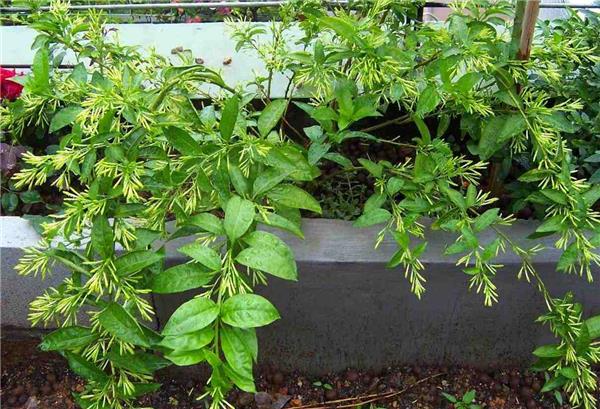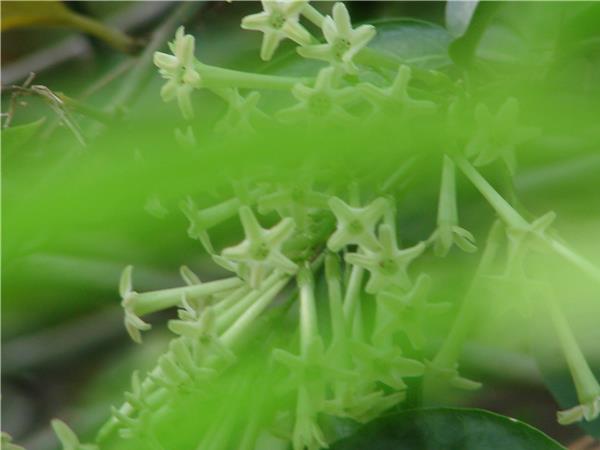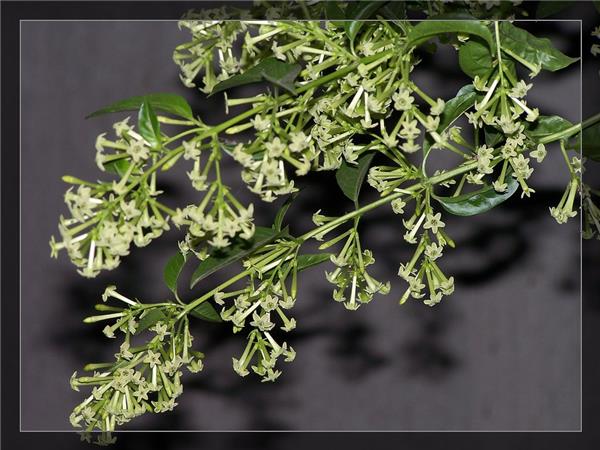The culture method of night incense
Night incense, blooming at night, will release a strong fragrance of flowers, so it is also called night incense, night orchid fragrance. So do you know how to breed it?

The culture method of evening primrose.
1. Prepare potted soil. Night incense like loose, well-drained, organic-rich acid soil. The pot soil is generally made of peat soil or rotten leaf soil with 3 parts of coarse river mud and 2 parts of coarse river mud and a small amount of farm manure. When potted, the bottom is about 1 to 5 deeply filled with broken bricks in shape to facilitate basin drainage, and the upper part is cultivated with mixed basin soil.
2. Suitable environment. Potted night incense requires well-ventilated environmental conditions. From the beginning of May to the end of September, it is appropriate to put sufficient sunshine in the hospital or maintenance on the balcony. Although it likes adequate sunshine, it should avoid hot sun exposure at noon in summer.
3. Fertilization. In the process of its growth, liquid fertilizer should be applied every 10 to 15 days, and thin liquid fertilizer should be applied every half a month since late April, so that it can blossom continuously from the middle of May. If high efficiency humic acid liquid fertilizer such as Chunquan 883 or Huimanfeng can be applied, the effect is better.
4. Transfer water. Its summer is the peak growing season, in addition to the application of sufficient fertilizer, the basin soil must be kept moist and watered twice a day. If it is a seedling, it should be sprayed to the leaves once or twice a day.
5. Suitable temperature. It should be moved into the greenhouse in the middle and last ten days of October every year, and the temperature of the greenhouse should be kept from 8 ℃ to 12 ℃. If the temperature is lower than 5 ℃, the leaves will wither and fall off until death.
6. Change the basin. The basin change should be carried out before coming out of the room in early April. When changing the basin, part of the old soil and roots should be removed, replaced with new culture soil, and re-cut to promote the development of new branches. After changing the basin, you should keep the soil moist, but there can be no stagnant water in the basin. If you find that the tender leaves droop slightly after changing the basin, you should water them in time.

7. Adjust the plant shape. Scaffolding should be set up in cultivation and management, plants should be topped in time to promote more branches, residual pedicels should be cut off in time after blooming, fertilizer should be added, withered branches and overdense branches should be cut off after blooming, and overgrown branches should be truncated.
The breeding method of nocturnal incense.
First, cut in and breed.
1. Choose the insert. The branches with strong growth and free of diseases and insect pests should be selected, and the sunny branches in the middle and upper part of the year should be selected on the same plant, requiring short internodes, strong branches and leaves, full bud tips, and unsuitable branches and overgrown branches that are about to bloom.
two。 Choose the matrix. The bed soil prepared with peat soil and rotten leaf soil is 3 ∶ 3 ∶ 4 respectively. The bed soil prepared in this way has the characteristics of increasing bed temperature, water retention, aeration, fertility and partial acidity, and is suitable for branches to take root and sprout.
3. Deal with the inserts. The cuttings were treated with ABT rooting powder before cutting, which had the effect of promoting rooting. Cut the cuttings into a section of 8 to 12 centimeters, with 2 to 3 buds above. The cut in the lower part of the cuttings should be 0.5 centimeters below the node, and the cut should be smooth, cutting off the lower leaves, leaving only 2 to 3 leaves at the top. The insertion depth is generally about 3 centimeters.
4. Create the conditions for rooting. The suitable rooting temperature is 20 ℃ to 24 ℃, and the soil temperature is 3 ℃ to 5 ℃ higher than the air temperature. The relative humidity of the bed air is 80% to 90%, which is favorable for rooting and requires light of about 30%. The moisture should be suitable, which is slightly higher at the initial stage and slightly dry at the later stage. The suitable period for local open-field planting is from early May to mid-June, when the climate is better, which can better meet the temperature and humidity conditions needed for cuttings to take root.
5. Strengthen the management after insertion. After insertion, it should be watered thoroughly, covered with plastic film, placed in a shaded place, or sprinkled with grass on the film to prevent direct sunlight, and increase light at night to help it survive. Air is released once or twice a day to replenish the oxygen needed and prevent diseases. To often spray water, keep the inserting bed moderately moist, but do not spray too much water, otherwise the inserting bed is too wet, often affecting the cuttings healing and rooting. When the new root grows to 2 to 3 meters, it can be transplanted into the basin at the right time.
Second, the method of pot planting.
1. Prepare potted soil. Night incense like loose, well-drained, organic-rich acid soil. The pot soil is generally made of peat soil or rotten leaf soil with 3 parts of coarse river mud and 2 parts of coarse river mud and a small amount of farm manure. When potted, the bottom is about 1 to 5 deeply filled with broken bricks in shape to facilitate basin drainage, and the upper part is cultivated with mixed basin soil.

two。 Suitable for the environment. Potted night incense requires well-ventilated environmental conditions. From the beginning of May to the end of September, it is appropriate to put sufficient sunshine in the hospital or maintenance on the balcony. Although it likes adequate sunshine, it should avoid hot sun exposure at noon in summer.
3. Fertilize. In the process of its growth, liquid fertilizer should be applied every 10 to 15 days, and thin liquid fertilizer should be applied every half a month since late April, so that it can blossom continuously from the middle of May. If high efficiency humic acid liquid fertilizer such as Chunquan 883 or Huimanfeng can be applied, the effect is better.
4. Transfer water. Its summer is the peak growing season, in addition to the application of sufficient fertilizer, the basin soil must be kept moist and watered twice a day. If it is a seedling, it should be sprayed to the leaves once or twice a day.
5. Moderate temperature. It should be moved into the greenhouse in the middle and last ten days of October every year, and the temperature of the greenhouse should be kept from 8 ℃ to 12 ℃. If the temperature is lower than 5 ℃, the leaves will wither and fall off until death.
6. Change the basin. The basin change should be carried out before coming out of the room in early April. When changing the basin, part of the old soil and roots should be removed, replaced with new culture soil, and re-cut to promote the development of new branches. After changing the basin, you should keep the soil moist, but there can be no stagnant water in the basin. If you find that the tender leaves droop slightly after changing the basin, you should water them in time.
7. Adjust the plant shape. Scaffolding should be set up in cultivation and management, plants should be topped in time to promote more branches, residual pedicels should be cut off in time after blooming, fertilizer should be added, and withered branches and over-dense branches should be cut off after blooming.
8. Cure insects. It is often harmed by aphids and shell insects, which can be controlled by Uranus, cypermethrin and Kuaishaling.
Matters needing attention in the culture of evening primrose.
Nocturnal incense should not be kept indoors. The aroma of nocturnal incense can make patients with high blood pressure and heart disease feel dizzy, depressed and uncomfortable, causing chest tightness and breathing difficulties, so nocturnal incense is not suitable for indoor display. It is best to put it outside as an ornamental plant. The hometown of nocturnal incense is in tropical Asia, where the temperature is high during the day and flying insects seldom come out. In the evening and night, when the temperature drops, many flying insects come out to look for food. At this time, nocturnal incense emits a strong fragrance, attracting flying insects to come and spread pollen. Under the influence of environmental factors for generations, nocturnal incense has formed the habit of always sending out fragrance at night. If you put it indoors for a long time, it will cause dizziness, cough, and even asthma and insomnia.
Night incense is a kind of fertilizer-loving plant, so it should be fertilized in a small amount and many times in the process of its growth. Friends who plant night incense should pay attention to one thing.

The function of the culture method of night incense.
1. Watch. Night incense has slender branches, blooming in summer and autumn, and yellow-green flowers blooming in the evening. It is often used to decorate courtyards, windows, ponds and pavilions in the south, with a certain ornamental value.
2. For medicinal use. Night incense can be used as medicine, with the effect of clearing the liver and eyesight, can treat eye swelling and pain, measles on the eyes, corneal nebula, and so on.
3. Edible. Evening primrose is edible, mainly for its fresh flowers and buds. It is a semi-wild vegetable.
4. Repelling mosquitoes. Night incense is relatively strong, and has a certain degree of toxicity, so it can expel mosquitoes, which is also a convenience to life, usually covering the windows with screens and planting plants outdoors.
If the temperature is lower than 5 ℃, the leaves will wither and fall off until death.
6. Change the basin. The basin change should be carried out before coming out of the room in early April. When changing the basin, part of the old soil and roots should be removed, replaced with new culture soil, and re-cut to promote the development of new branches. After changing the basin, you should keep the soil moist, but there can be no stagnant water in the basin. If you find that the tender leaves droop slightly after changing the basin, you should water them in time.
7. Adjust the plant shape. Scaffolding should be set up in cultivation and management, plants should be topped in time to promote more branches, residual pedicels should be cut off in time after blooming, fertilizer should be added, and withered branches and over-dense branches should be cut off after blooming.
8. Cure insects. It is often harmed by aphids and shell insects, which can be controlled by Uranus, cypermethrin and Kuaishaling.
Matters needing attention in the culture of evening primrose.
Nocturnal incense should not be kept indoors. The aroma of nocturnal incense can make patients with high blood pressure and heart disease feel dizzy, depressed and uncomfortable, causing chest tightness and breathing difficulties, so nocturnal incense is not suitable for indoor display. It is best to put it outside as an ornamental plant. The hometown of nocturnal incense is in tropical Asia, where the temperature is high during the day and flying insects seldom come out. In the evening and night, when the temperature drops, many flying insects come out to look for food. At this time, nocturnal incense emits a strong fragrance, attracting flying insects to come and spread pollen. Under the influence of environmental factors for generations, nocturnal incense has formed the habit of always sending out fragrance at night. If you put it indoors for a long time, it will cause dizziness, cough, and even asthma and insomnia.
Night incense is a kind of fertilizer-loving plant, so it should be fertilized in a small amount and many times in the process of its growth. Friends who plant night incense should pay attention to one thing.

The function of the culture method of night incense.
1. Watch. Night incense has slender branches, blooming in summer and autumn, and yellow-green flowers blooming in the evening. It is often used to decorate courtyards, windows, ponds and pavilions in the south, with a certain ornamental value.
2. For medicinal use. Night incense can be used as medicine, with the effect of clearing the liver and eyesight, can treat eye swelling and pain, measles on the eyes, corneal nebula, and so on.
3. Edible. Evening primrose is edible, mainly for its fresh flowers and buds. It is a semi-wild vegetable.
4. Repelling mosquitoes. Night incense is relatively strong, and has a certain degree of toxicity, so it can expel mosquitoes, which is also a convenience to life, usually covering the windows with screens and planting plants outdoors.
Related
- Wuhan Hospital Iron Tree Blooming Result Was Instantly Frightened by the Gardener Master
- Which variety of camellia is the most fragrant and best? Which one do you like best?
- What is the small blue coat, the breeding methods and matters needing attention of the succulent plant
- Dormancy time and maintenance management of succulent plants during dormancy
- Minas succulent how to raise, Minas succulent plant pictures
- What are the varieties of winter succulent plants
- How to raise succulent plants in twelve rolls? let's take a look at some experience of breeding twelve rolls.
- Attention should be paid to water control for succulent plants during dormant period (winter and summer)
- Watering experience of twelve rolls of succulent plants
- Techniques for fertilizing succulent plants. An article will let you know how to fertilize succulent plants.



